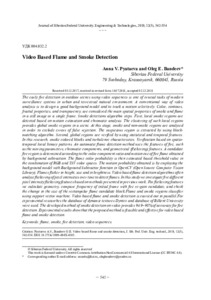Показать сокращенную информацию
Обнаружение пламени и дыма по видеоданным
| Автор | Пятаева, А.В. | ru_RU |
| Автор | Бандеев, О.Е. | ru_RU |
| Автор | Pyataeva, Anna V. | en |
| Автор | Bandeev, Oleg E. | en |
| Дата внесения | 2018-11-27T04:06:35Z | |
| Дата, когда ресурс стал доступен | 2018-11-27T04:06:35Z | |
| Дата публикации | 2018 | |
| URI (для ссылок/цитирований) | https://elib.sfu-kras.ru/handle/2311/109070 | |
| Аннотация | В работе предложен алгоритм обнаружения пожара по видеоданным на открытых пространствах, когда традиционными способами на основе датчиков химического состава воздуха или температуры обнаружение дыма и пламени невозможно. Обнаружение дыма и пламени выполняется параллельно, пожар считается найденным в случае детектирования одного объекта: дыма или пламени. Алгоритм нахождения дыма и пламени основан на анализе пространственно-временных признаков. На первом этапе обнаружения дыма выполняется поиск движения с использованием алгоритма сопоставления блоков, затем производится хроматический анализ движущихся областей, учет турбулентности. Классификация областей-кандидатов производится с использованием машины опорных векторов. Верификация выполнена на базе пространственно-временных локальных бинарных шаблонов. Для обнаружения пламени взята функция Background Subtraction библиотеки компьютерного зрения OpenCV, выполнен учет цветовых особенностей пламени и анализ его динамических свойств. Для проведения экспериментальных исследований использованы базы данных видеопоследовательностей Билькентского университета и Dyntex. Дополнительно репрезентативность тестового набора видеороликов повышена данными с реальных камер видеонаблюдения, в том числе полученными в ночное время. Количество кадров тестовых видеопоследовательностей составило 44 406, общая продолжительность роликов – 40 мин. Средняя точность обнаружения дыма составила 98 %, пламени – 94,9 %. Ложноположительные срабатывания при обнаружении дыма и пламени в среднем равны 3,46 %. Таким образом, экспериментальные исследования подтверждают эффективность предложенного алгоритма обнаружения пламени и дыма по видеопоследовательностям на открытых пространствах | ru_RU |
| Аннотация | The early fire detection in outdoor scenes using video sequences is one of crucial tasks of modern surveillance systems in urban and terrestrial natural environment. A conventional way of video analysis is to design a good background model and to track a motion selectively. Color, contours, fractal properties, and transparency, are considered the main spatial properties of smoke and flame in a still image or a single frame. Smoke detections algorithm steps. First, local smoke regions are detected based on motion estimation and chromatic analysis. The clustering of such local regions provides global smoke regions in a scene. At this stage, smoke and non-smoke regions are analyzed in order to exclude errors of false rejection. The suspicious region is extracted by using blockmatching algorithm. Second, global regions are verified by using statistical and temporal features. In this research, smoke colored blocks and turbulence characteristics. Verification based on spatiotemporal local binary patterns. An automatic flame detection method uses the features of fire, such as the moving parameters, chromatic components, and geometrical (flickering) features. A candidate fire region is determined according to the color component ratio and motion cue of fire flame obtained by background subtraction. The flame color probability is then estimated based threshold value in the combination of RGB and YSV color spaces. The motion probability obtained is by employing the background model with Background Subtractor function in OpenCV (Open Source Computer Vision Library). Flames flicker in height, size and in brightness. Video based flame detection algorithms often analyze flickering of pixel intensities over time to detect flames. In this study we investigate five different pixel intensity flickering features based on methods presented in previous work. For flickering features we calculate geometry, compare frequency of initial frame with fire re-gion candidate, and check the change in the size of the rectangular flame candidate block.Flame and smoke regions classifier using support vector machine. Video based flame and smoke detection is carried out in parallel.For experimental researches the database of dynamic textures Dyntex and database of Bilkent University were used. The developed method of smoke detection on video provides 94.9–98% of accuracy for fire detection. Experimental results show that the proposed method is feasible and effective for video based flame and smoke detection | en |
| Язык | ru | ru_RU |
| Издатель | Сибирский федеральный университет. Siberian Federal University | en |
| Тема | пламя | ru_RU |
| Тема | дым | ru_RU |
| Тема | обнаружение пожара | ru_RU |
| Тема | видеопоследовательности | ru_RU |
| Тема | flame | en |
| Тема | smoke | en |
| Тема | fire detection | en |
| Тема | video sequences | en |
| Название | Обнаружение пламени и дыма по видеоданным | ru_RU |
| Альтернативное название | Video Based Flame and Smoke Detection | en |
| Тип | Journal Article | ru_RU |
| Контакты автора | Пятаева, А.В.: Сибирский федеральный университет Россия, 660041, Красноярск, пр. Свободный, 79 | ru_RU |
| Контакты автора | Бандеев, О.Е.: Сибирский федеральный университет Россия, 660041, Красноярск, пр. Свободный, 79 | ru_RU |
| Контакты автора | Pyataeva, Anna V.: Siberian Federal University 79 Svobodny, Krasnoyarsk, 660041, Russia; anna4u@list.ru | en |
| Контакты автора | Bandeev, Oleg E.: Siberian Federal University 79 Svobodny, Krasnoyarsk, 660041, Russia; olegbandeev@yandex.ru | en |
| Страницы | 542-554 | |
| DOI | 10.17516/1999-494X-0105 | |
| Журнал | Журнал Сибирского федерального университета. Техника и технологии. Journal of Siberian Federal University. Engineering & Technologies: 2018 | en |

